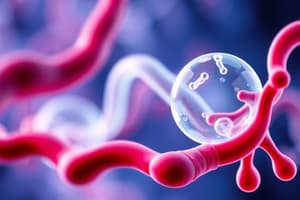Podcast
Questions and Answers
What is the first step of glycolysis?
What is the first step of glycolysis?
- Glucose is phosphorylated to glucose-6-phosphate. (correct)
- Fructose-6-phosphate is converted to fructose-1,6-bisphosphate.
- Dihydroxyacetone phosphate is converted to glyceraldehyde-3-phosphate.
- Phosphoenolpyruvate is converted to pyruvate.
Which enzyme is responsible for the committed step of glycolysis?
Which enzyme is responsible for the committed step of glycolysis?
- Hexokinase
- Pyruvate kinase
- Phosphofructokinase-1 (PFK-1) (correct)
- Aldolase
How many ATP molecules are consumed in the first half of glycolysis?
How many ATP molecules are consumed in the first half of glycolysis?
- 3 ATP molecules
- 2 ATP molecules (correct)
- 1 ATP molecule
- 4 ATP molecules
What is produced at the end of glycolysis under anaerobic conditions in muscle cells?
What is produced at the end of glycolysis under anaerobic conditions in muscle cells?
Which molecule activates the enzyme pyruvate kinase?
Which molecule activates the enzyme pyruvate kinase?
Which enzyme is responsible for the conversion of pyruvate to lactate under anaerobic conditions?
Which enzyme is responsible for the conversion of pyruvate to lactate under anaerobic conditions?
What is the net gain of ATP molecules at the end of glycolysis?
What is the net gain of ATP molecules at the end of glycolysis?
What role does glyceraldehyde-3-phosphate dehydrogenase (G3PDH) play in glycolysis?
What role does glyceraldehyde-3-phosphate dehydrogenase (G3PDH) play in glycolysis?
What is the role of triose phosphate isomerase in glycolysis?
What is the role of triose phosphate isomerase in glycolysis?
Which two molecules are considered high-energy intermediates in glycolysis?
Which two molecules are considered high-energy intermediates in glycolysis?
Which molecule inhibits phosphofructokinase-1 (PFK-1)?
Which molecule inhibits phosphofructokinase-1 (PFK-1)?
How does fructose-2,6-bisphosphate affect phosphofructokinase-1 (PFK-1)?
How does fructose-2,6-bisphosphate affect phosphofructokinase-1 (PFK-1)?
What is produced in glycolysis as NADH is generated?
What is produced in glycolysis as NADH is generated?
What is the primary function of substrate-level phosphorylation in glycolysis?
What is the primary function of substrate-level phosphorylation in glycolysis?
Which enzyme is activated by the depletion of ATP levels in the cell, contributing to increased glycolysis?
Which enzyme is activated by the depletion of ATP levels in the cell, contributing to increased glycolysis?
What does enolase catalyze in glycolysis that involves a dehydration reaction?
What does enolase catalyze in glycolysis that involves a dehydration reaction?
Flashcards are hidden until you start studying
Study Notes
Glycolysis Overview
- Glycolysis is a metabolic pathway that converts glucose into pyruvate, producing ATP and NADH.
- It consists of two phases: the energy investment phase and the energy payoff phase.
First Step of Glycolysis
- Glucose is phosphorylated to glucose-6-phosphate by hexokinase (or glucokinase in the liver).
Key Enzymes and Reactions
- Phosphofructokinase-1 (PFK-1) is the key regulatory enzyme in glycolysis.
- Fructose-6-phosphate is the substrate for PFK-1.
- The first committed step of glycolysis is the conversion of fructose-6-phosphate to fructose-1,6-bisphosphate by PFK-1.
Major Products
- The reaction catalyzed by PFK-1 produces fructose-1,6-bisphosphate.
- Aldolase converts fructose-1,6-bisphosphate into glyceraldehyde-3-phosphate (G3P) and dihydroxyacetone phosphate (DHAP).
- Triose phosphate isomerase interconverts DHAP and G3P.
ATP Consumption and Production
- Two ATP molecules are consumed during the first half of glycolysis.
- The second half generates four ATP molecules, leading to a net gain of two ATP.
End Products of Glycolysis
- Under anaerobic conditions in muscle cells, glycolysis ends with the production of lactate.
- In aerobic conditions, pyruvate is the final product.
Regulation of Key Enzymes
- Pyruvate kinase converts phosphoenolpyruvate (PEP) to pyruvate, with fructose-1,6-bisphosphate activating it and ATP and alanine inhibiting it.
- PFK-1 is inhibited by ATP and citrate but activated by AMP and fructose-2,6-bisphosphate.
- Hexokinase is inhibited by glucose-6-phosphate, its own product.
NADH and Oxidation
- NADH is regenerated in anaerobic conditions by reducing pyruvate to lactate, catalyzed by lactate dehydrogenase.
- The enzyme glyceraldehyde-3-phosphate dehydrogenase (G3PDH) uses NAD⁺ as a cofactor to catalyze the oxidation of G3P to 1,3-bisphosphoglycerate.
High-Energy Intermediates
- Key high-energy intermediates in glycolysis include 1,3-bisphosphoglycerate (1,3-BPG) and phosphoenolpyruvate (PEP).
Substrate-Level Phosphorylation
- This process directly generates ATP from ADP without requiring the electron transport chain, occurring at specific steps in glycolysis.
Other Reactions
- The conversion of 2-phosphoglycerate to phosphoenolpyruvate involves a dehydration reaction and is catalyzed by enolase, a type of lyase.
- The final step of glycolysis, catalyzed by pyruvate kinase, produces pyruvate.
Overall Regulation and Feedback
- High ATP levels inhibit glycolysis by negatively affecting PFK-1 activity, ultimately slowing down the pathway.
- Glycolysis is a crucial pathway for ATP production, particularly during anaerobic conditions and high energy demands.
Studying That Suits You
Use AI to generate personalized quizzes and flashcards to suit your learning preferences.




